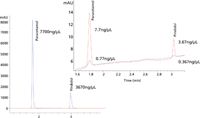HPLC UV Determination of Very High and Very Low Concentrations of Compounds in One Run
The Application Notebook
Agilent Technologies
The Agilent 1200 Infinity Series HDR-DAD Impurity Analyzer System covers a wide linear range typically up to 6000 mAU and enables the analysis of impurities typically down to 0.2 mAU. Very high and very low concentrations are determined in one run, saving time and labour.
The determination of very high and very low concentrations in one run using the same injection volume is often not possible due to the limited linear range of conventional UV detectors. The Agilent 1200 Infinity Series HDR-DAD Impurity Analyzer covers a wide linear range, typically up to 6000 mAU. In addition, the system typically exhibits low noise and provides for the quantification of peaks with heights below 0.5 mAU. As examples, the determination of paracetamol and pindolol over a wide linear range and the analysis of doxycycline and its very low concentrated impurities and degradation products were chosen.
Results
The determination of log P, the distribution of a compound between water and octanol, is frequently used in the pharmaceutical industry and needs a high linear range to be able to determine the low and high concentrated compound in the water or octanol phase or vice versa in one run (Figure 1). To test the linearity, paracetamol and pindolol were analyzed with good correlation from 0.77 ng/μL to 7700 ng/μL and from 0.367 ng/μL to 3670 ng/μL, respectively (1).

Figure 1: Three example runs with different concentrations, linearity from 8000 mAU down to
When exposed to heat and light, tetracyclines undergo epimerization and degradation. Often, the degradation products have very low antibiotic activity, and some are toxic. Doxycycline was exposed to light and elevated temperature for days to determine decomposition products. After 5.5 days of exposure, the percentage of doxycycline was reduced by 5.3%, while additional impurities occurred and the amount of impurities already present in the original solution increased proportionally. It was possible to detect impurities down to < 0.2 mAU of peak height (Figure 2) (2).

Figure 2: Analysis of doxycycline impurities.
Conclusions
Quantification of significantly different concentration levels present in the water and the octanol phase for determination of log P were performed without the need of injection volume adaption. Peak heights up to 8000 mAU were calibrated and quantified by means of the wide linear range of the Agilent 1200 Infinity Series HDR-DAD Analyzer System. In addition, the 1200 Infinity Series HDR-DAD typically exhibits low noise and provides for the quantification of peaks with peak heights below 0.125 mAU as are present for impurities after decomposition of doxycycline.
References
(1) A.G. Huesgen, "Determination of Log P for Compounds of Different Polarity Using the Agilent 1200 Infinity Series HDR-DAD Impurity Analyzer System," Agilent Application Note, publication number 5991-4121EN, 2014.
(2) A.G. Huesgen, "Analysis of Degradation Products of Doxycycline in Solution Exposed to Light and Elevated Temperatures Using the Agilent 1200 Infinity Series High Dynamic Range Diode Array Detector Impurity Analyzer System," Agilent Application Note, publication number 5991-4044EN, 2014.
Agilent Technologies Inc.
5301 Stevens Creek Blvd., Santa Clara, California 95051, USA
Website: www.agilent.com

Investigating 3D-Printable Stationary Phases in Liquid Chromatography
May 7th 20253D printing technology has potential in chromatography, but a major challenge is developing materials with both high porosity and robust mechanical properties. Recently, scientists compared the separation performances of eight different 3D printable stationary phases.
Detecting Hyper-Fast Chromatographic Peaks Using Ion Mobility Spectrometry
May 6th 2025Ion mobility spectrometers can detect trace compounds quickly, though they can face various issues with detecting certain peaks. University of Hannover scientists created a new system for resolving hyper-fast gas chromatography (GC) peaks.
University of Oklahoma and UC Davis Researchers Probe Lipidomic Profiles with RP-LC–HRMS/MS
May 6th 2025A joint study between the University of Oklahoma Health Sciences Center (Oklahoma City, Oklahoma) and the UC Davis West Coast Metabolomics Center (Davis, California) identified differentially regulated lipids in type 2 diabetes (T2D) and obesity through the application of reversed-phase liquid chromatography-accurate mass tandem mass spectrometry (RP-LC-accurate MS/MS).

.png&w=3840&q=75)

.png&w=3840&q=75)



.png&w=3840&q=75)



.png&w=3840&q=75)

















